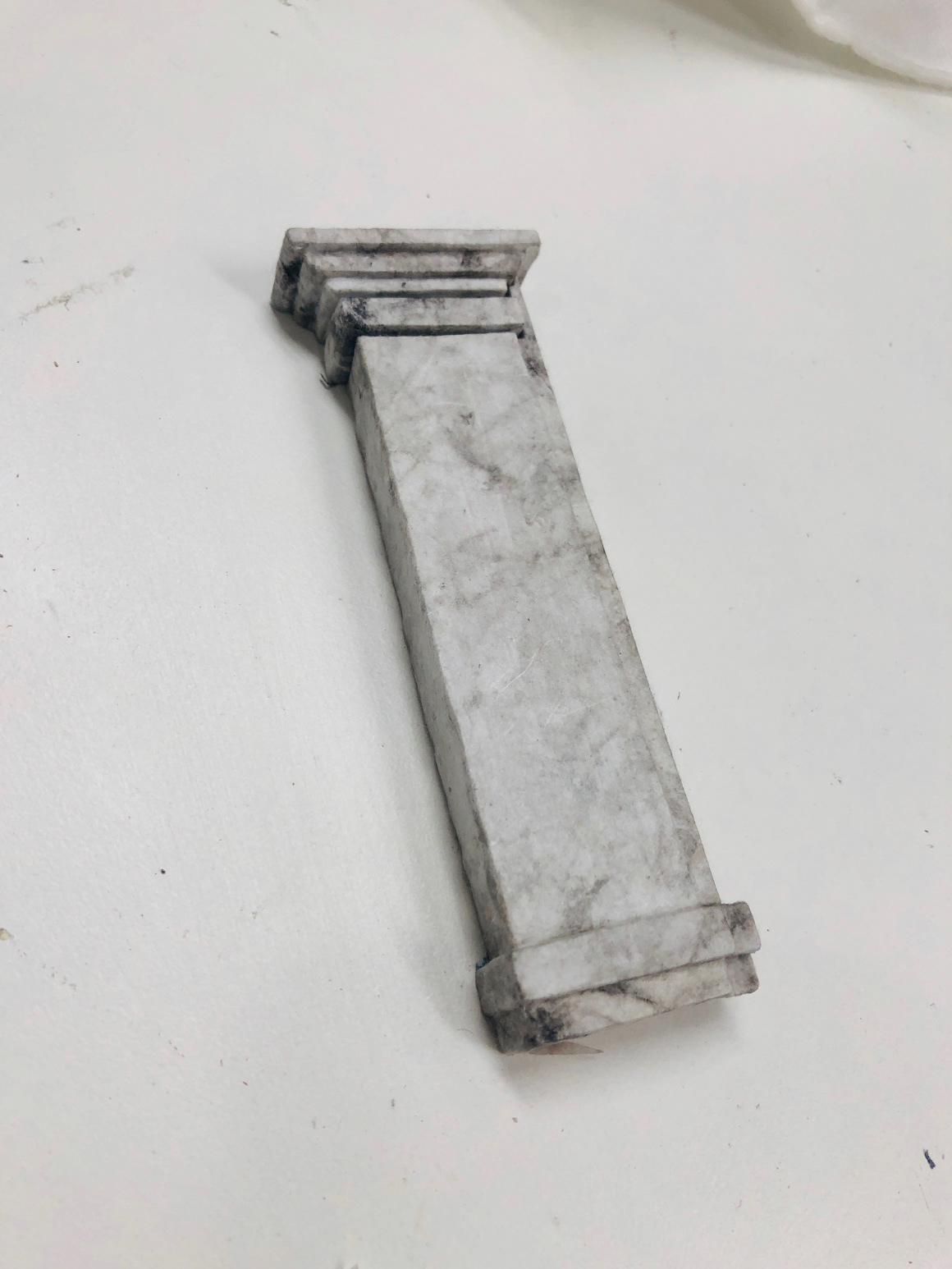<< Tranquil Trace >>
바랜다는 것은 무엇일까? 빛깔은 점점 사라진다. 서서히 진행되어 눈치 챌 새 없이 문득 돌아보면 색이 바래어 있다.바래진 빛깔 앞에 서면 고요함이 보인다. 언뜻 포착한 바램에서 그곳이 겪었을 시간을 발견한다. 고요함은 그렇게 찾아온다.
이곤의 개인전 <Tranquil Trace>에서 선보이는 새로운 시리즈는 오랜 시간 빛에 노출되면서 바래진 색을 갖게된 건물이 지닌 고요함을 평면으로 옮긴 작업이다. 우리 주변에는 꽤 오래전부터 한자리를 차지하고 지켜온 건물들이 있다. 짧게는 수십 년간, 길게는 수백년 간 동일한 위치에서 지금도 여전히 같은 모양새를 유지하고 있다. 헌데 모든 일에는 그만큼의 대가가 따르듯, 건물도 꿋꿋하게 제 위치를 고수하기 위해서는 일정한 비용을 치른다. 바로 ‘시간과의 작용’이다. 건물 외부에 자리한 벽, 기와, 장식들은 처음 지어졌을 때부터 허물어지기 전까지 빛과 함께 지낸다. 장시간 외부에 노출되는 필연적인 운명은 건물이 본연의 색을 잃음으로써 일종의 값을 지불하게 한다. 그 모습을 보며 누군가는 연민을 느끼기도 하고 못 본 척 무심하게 지나가기도 한다.
그러나 이곤은 계속해서 대가를 지불하는 건물을 통해 새로이 마음이 동하는 지점을 발견하고 작업으로 끌어온다. 시간에 의해 건물 색이 빠지는 것을 보면서 그는 건물이 색을 “잃은 것”이 아니라 건물의 색이 “바랬다”고 읽는다. 그리고 그것이 대가를 지불하는 것이 아니라, 흔적을 남기게 되었다고 여긴다.
천연 재료로 염색한 한지를 작은 나무 판에 붙여 하나의 조각을 만들고, 그 조각들을 한데 모아 건물의 외형을 닮은 화면을 구성한다. 종묘, 대한의원, 서대문형무소 등 형상의 구체적인 참조는 분명히 실재한다. 그렇다고 굳이 그 정체를 명확하게 알 필요는 없다. 이곤이 오랜 시간 존재해온 이 건물, 저 건물에서 동일하게 발견한 고요함이라는 흔적을 발견하고 평면으로 옮겼다는 점이 핵심이다. 그가 만든 작은 조각은 꽤 오랜 시간에 걸쳐 하나의 이미지로 뭉쳐진다. 또 그 속에는 애초에 우연적으로 염색될 수밖에 없고, 물이 든 이후에도 시간이 지남에 따라 변할 수 밖에 없는 운명을 품은 색 종이들이 있다. 이는 사람의 손으로 한 땀 한 땀 벽돌이 쌓이고, 기와가 겹쳐지며 완성되는 실제 건물의 생성과정과 완성 후 지속적으로 빛을 받아 색이 빠져나가는 감색 과정과 닮았다.
바랜다는 가능성이 내재된 건물의 색은 단 한가지로 규정되지 않는다. 빛이 바랜다는 말은 빛깔이 바랜다는 뜻으로, 물체가 빛을 받을 때 생긴 파장의 색이 점점 흐려져간다는 의미이다. 즉, 건물의 색은 하나로 아우를 수 없는 파장이 가진 모호한 색의 ‘범위’로 우리 눈에 인식된다. 그래서 우리는 벽돌이 빨갛지 않고 불그스름하며, 기와가 까맣지 않고 검다고 말할 수 있다. 이 넓게 퍼진 색의 모호함은 이곤에게 고요함으로 다가온다. 어딘가에 속하는 듯 속하지 않고 일렁임과 같은 잔잔함, 고요함을 준다. 이렇게 건물들은 저마다 모호해진 색이 되어 우리 눈을 통과하고 기억으로 돌아온다. 곁에 가까이 있지 않더라도, 혹은 급기야 허물어지더라도. 우리 기억 속에서 그 어렴풋하고 고요한 존재가 흔적처럼 남아 지속된다.
이곤은 스스로 고고학자가 되고 싶었다고 말한다. 그러난 있는 것을 찾아내는 고고학자는 아니었다. 오히려 없는 것을 찾지 못하는 고고학자가 아니었을까. 무언가가 없기 때문에 찾고 싶은 것을 상상할 수 있었던 것이다. 그렇게 새로움을 발굴하게 되었을 터. <Tranquil Trace>는 2019년의 이곤이 찾은 새로움들을 만나는 현장이라고 할 수 있겠다. 이곤이 단 한번도 열어본 적 없는 기억의 파도의 잔잔함과 닮은 건물의 고요함을 평면이라는 시각으로 펼쳐 놓았다. 이제 누군가가 다시 여기서 그의 발견을 전달 받을 차례다. 이곤이 앞으로 찾아낸 새로움을 기다리며, 그가 전하는 고요함이 우리에게 찾아온다.
<< Tranquil Trace >>
What does it mean to fade away? Colors fade gradually. If you glance back after some time, you suddenly realize that the color has faded unnoticed.
The new series in eGon's solo exhibition <Tranquil Trace> is transfer to a flat plane the tranquility possessed by buildings displaying faded colors that have been exposed to light over great spans of time.
Around us there are buildings that have occupied and guarded the same space for a long time. They maintain the same form in the same place for decades or even centuries.
The new series in eGon's solo exhibition <Tranquil Trace> is transfer to a flat plane the tranquility possessed by buildings displaying faded colors that have been exposed to light over great spans of time.
Around us there are buildings that have occupied and guarded the same space for a long time. They maintain the same form in the same place for decades or even centuries.
However, just as everything has a price, buildings pay a certain price to stubbornly maintain their positions. The price is "interaction with time."
The building's exterior walls, roof tiles, and decorations coexist with light from the time of construction until destruction. The inevitable fate of being exposed to the outside for a long time causes the building to pay a kind of price by losing its original color. Seeing this, some people feel a sympathetic connection; others pass by nonchalantly. But eGon, through the buildings that are paying the price of time, discovers a point that moves us in a fresh way. Watching the colors of buildings change over time, he recognizes that the colors have faded, which is not the same as "losing" color. And he views this not as payment, but as remaining traces of time.
The building's exterior walls, roof tiles, and decorations coexist with light from the time of construction until destruction. The inevitable fate of being exposed to the outside for a long time causes the building to pay a kind of price by losing its original color. Seeing this, some people feel a sympathetic connection; others pass by nonchalantly. But eGon, through the buildings that are paying the price of time, discovers a point that moves us in a fresh way. Watching the colors of buildings change over time, he recognizes that the colors have faded, which is not the same as "losing" color. And he views this not as payment, but as remaining traces of time.
A piece is made by attaching hanji dyed with natural materials to a small wooden plate, and the pieces are combined to form a screen that resembles the exterior of a building. The specific referents, such as Jongmyo, Daehan clinic, Seodaemun Prison, are certainly real. Nevertheless it is not necessary to actually know the nature of the referents. The key point is that eGon discovered the traces of tranquility common to this and that building that have survived through time, and transferred them to the plane. The small pieces that he crafts take quite a long time to combine into one image. And within the pieces are bits of colored paper that embrace the fate of being randomly dyed, and then changing over time after being dyed. his process resembles both the manual brick-by-brick and tile-over-tile construction, and the continuous fading under light, of real buildings
A building's color, which possess the inherent potential for fading, cannot be fixed as one particular color. Fading means that the frequency of light reflected off a building becomes gradually more pale. In other words, the color of a building is not one but a range of frequencies recognized by our eyes.
Therefore, we can say bricks are not red, but are reddish, tiles are not black but blackish. This broad ambiguity of color strikes eGon as tranquility. It is belonging but not belonging, a quiet and gentle swaying. n this way, the buildings, through
Therefore, we can say bricks are not red, but are reddish, tiles are not black but blackish. This broad ambiguity of color strikes eGon as tranquility. It is belonging but not belonging, a quiet and gentle swaying. n this way, the buildings, through

